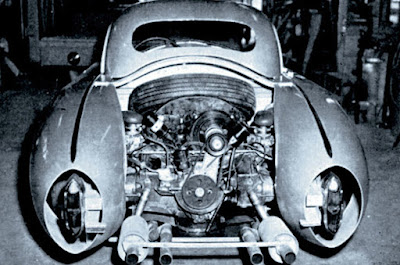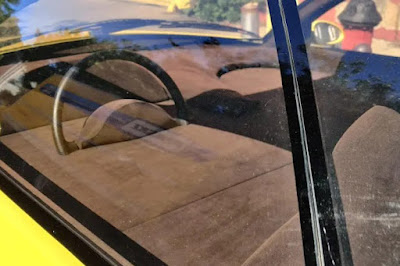⛔ THE LEGEND 💣 - Maserati, the iconic Italian automotive brand steeped in history since 1914 and now part of Fiat, is a name synonymous with luxury, performance, and style. Over the years, Maserati has produced a myriad of car models, showcasing its prowess in both the consumer market and the high-stakes world of racing.

 |
| 1957 Maserati 450S Costin-Zagato Coupe was handbuilt by Zagato in Italy by following the Costin specifications. (Picture from: Wikipedia) |

One standout creation from Maserati's rich history is the Maserati 450S Costin-Zagato Coupe, a race car crafted to compete in the 1957 World Sportscar Championship, representing Italy's automotive excellence on the global stage.
 |
| 1957 Maserati 450S Costin-Zagato Coupe uses a 8-cylinder, 4.5 liter engine able to spew up to 400 hp of power. (Picture from: Supercars) |
 Originally conceived as a barchetta in 1956 and piloted by racing legend Juan Manuel Fangio in Buenos Aires, the car underwent a transformation in 1957 under the design genius of British automotive designer Frank Costin. The result was a stunning coupe variant, handcrafted by Zagato in Italy to precise Costin specifications, thus earning its distinctive hyphenated name.
Originally conceived as a barchetta in 1956 and piloted by racing legend Juan Manuel Fangio in Buenos Aires, the car underwent a transformation in 1957 under the design genius of British automotive designer Frank Costin. The result was a stunning coupe variant, handcrafted by Zagato in Italy to precise Costin specifications, thus earning its distinctive hyphenated name.Zagato's craftsmanship shone through in the coupe's lightweight aluminum body, adding a mere 65 kg compared to its barchetta counterpart. This emphasis on lightweight construction contributed significantly to the car's performance, making it a formidable contender on the racing circuit.
 |
| Interior view of the Maserati 450S Costin-Zagato Coupe, as seen during Maserati's centenary celebration back in 2015. (Picture from: Otoblitz) |
Dubbed 'Il Mostro' (The Monster) by Zagato, the car earned this moniker due to its striking design, meticulously honed for optimal functionality, paired with a potent 8-cylinder, 4.5-liter engine generating a staggering 400 hp.
The Maserati 450S took on formidable rivals like Ferrari and Jaguar at the prestigious 24 Hours of Le Mans, piloted by the legendary Stirling Moss and Harry Schell. Despite starting from second place, the car showcased its speed, leading the race for several laps with a top speed of 320 kph. However, an unfortunate engine failure prevented it from finishing the race.
 |
| 1957 Maserati 450S Costin-Zagato Coupe changed into a road-legal car after purchased by an American car fans named Byron Staver in 1958. (Picture from: Otoblitz) |
Post-Le Mans, the car underwent a transformation, becoming road-legal under the ownership of American enthusiast Byron Staver, who tastefully repainted it in elegant black, departing from its original 'rosso corsa' hue.
Renumbered as 4512 by Maserati and further refined by Fantuzzi, the coupe exchanged hands over the years, finding a temporary home at the Rosso Bianco Museum in Germany from 1978 to 2002. Resurrected by Maserati collector Alfredo Brener in 2002 after restoration in Italy, the car stands as a testament to Maserati and Zagato's enduring legacy in automotive excellence.
 |
| Later this 1957 Maserati 450S Costin-Zagato Coupe inspired the new car named Maserati Zagato Mostro in 2015. (Picture from: Aeromobilia) |
In a poignant tribute to its heritage, Maserati unveiled the Maserati Zagato Mostro supercar in 2015, drawing inspiration from the iconic Maserati 450S Costin-Zagato Coupe, a fitting homage to a timeless masterpiece that continues to captivate enthusiasts worldwide. | cf1JOLm493U |
 The journey of the Maserati 450S Costin-Zagato Coupe encapsulates the intersection of artistry, engineering, and racing prowess, showcasing the enduring allure of Italian automotive craftsmanship through the annals of time. *** [EKA [09112020] | FROM VARIOUS SOURCES | CARSTYLING | SUPERCARS] AUTOMOTIVPRESS.FR | GOODWOOD ROAD&RACING | WIKIPEDIA ]
The journey of the Maserati 450S Costin-Zagato Coupe encapsulates the intersection of artistry, engineering, and racing prowess, showcasing the enduring allure of Italian automotive craftsmanship through the annals of time. *** [EKA [09112020] | FROM VARIOUS SOURCES | CARSTYLING | SUPERCARS] AUTOMOTIVPRESS.FR | GOODWOOD ROAD&RACING | WIKIPEDIA ]Note: This blog can be accessed via your smart phone





































